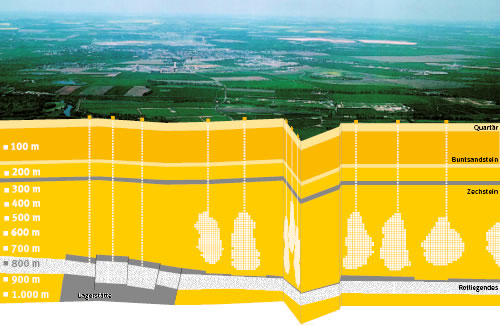Hydrogen energy storage in caverns
As part of the HYPOS research initiative, on May 1st, a pilot project for the underground storage of hydrogen in Central Germany will get underway. The aim of the project “H2 Research Cavern” is the development and regulatory approval of a research platform for the storage of hydrogen in a salt cavern. The storage facility is to be constructed after the end of the two-year research project at the Bad Lauchstädt (Saxony-Anhalt) operating site of the gas storage operator VNG Gasspeicher GmbH (VGS) and subsequently transferred to research operations. The facility would be the first hydrogen cavern storage facility in continental Europe, and the first cavern storage facility in the entire world that stores green hydrogen from renewable energies. Thanks to the convenient, site-specific location, the cavern can be connected to the existing hydrogen infrastructure in Central Germany’s chemical triangle (Leuna-Schkopau-Bitterfeld) utilizing an existing gas pipeline from ONTRAS Gastransport GmbH (ONTRAS) or one that would need to be repurposed.


Model Region for Hydrogen
The research cavern in Bad Lauchstädt is part of an overall concept for the development of a model region for hydrogen in the new federal states. At the heart of the concept is the supply of the model region with green hydrogen. This is to be obtained from renewable electrical energy with the help of power-to-gas technologies (large electrolyzers). The gas infrastructure would facilitate the supply of green hydrogen to recipients in the chemical industry, in the mobility sector, and in urban energy supply. “In addition, we can use the cavern to store green hydrogen resulting from overcapacities from renewable electricity production and discharge it again as needed. In this way, we maintain a large, seasonal reservoir that, in combination with power-to-gas, provides a unique opportunity of this scope to avoid shortages in supply with fluctuating renewable energies and to thereby ensure security of supply,” explains Stefan Bergander, Project and Innovation Manager at HYPOS e. V.
Parallel project on the fundamentals of hydrogen storage
The parallel HYPOS research project “H2-UGS”, in which the basic research on hydrogen storage in caverns is performed, has already been underway since September 2018. The project results are to be incorporated directly into the project “H2 Research Cavern” as a guideline for the construction of underground hydrogen storage facilities.
The project
Taking part in the “H2 Research Cavern” project are, along with the gas infrastructure operators VGS and ONTRAS, the DBI – Gastechnologisches Institut gGmbH Freiberg, the Fraunhofer Institute for Microstructure of Materials and Systems IMWS, the IfG – Institut für Gebirgsmechanik GmbH, as well as associated partners Linde AG and Terrawatt Planungsgesellschaft mbH. All project partners are members of the HYPOS consortium. HYPOS researches all aspects along the value-creation chain concerning green hydrogen in order to further increase the contribution of regeneratively generated hydrogen as a key source of energy in the energy revolution. The project is supported within the scope of the Zwanzig20 research initiative from the Federal Ministry for Education and Research (BMBF) and has a total budget of approx. 1.3 million Euros.